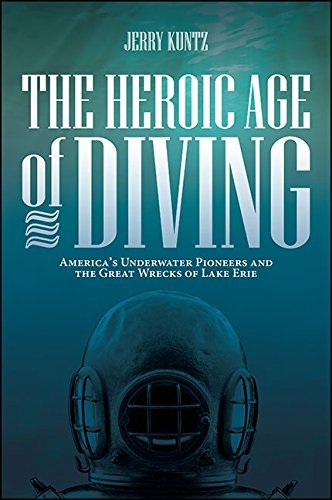The Heroic Age of Diving: America’s Underwater Pioneers and the Great Wrecks of Lake Erie
Jerry Kuntz
 In his work, The Heroic Age of Diving: America’s Underwater Pioneers and the Great Wrecks of Lake Erie, Jerry Kuntz focuses on the evolution of diving in the United States from 1820-1891 with a particular focus on Lake Erie. He breaks the book into three main sections called The Pioneers (1820s-1852), The Heroic Age of Diving (July 1852-1856), and The Aftermath (1857-1891). Each section can be read on its own and stand-alone which is refreshing to see, but the reader receives the big picture through reading it in its entirety.
In his work, The Heroic Age of Diving: America’s Underwater Pioneers and the Great Wrecks of Lake Erie, Jerry Kuntz focuses on the evolution of diving in the United States from 1820-1891 with a particular focus on Lake Erie. He breaks the book into three main sections called The Pioneers (1820s-1852), The Heroic Age of Diving (July 1852-1856), and The Aftermath (1857-1891). Each section can be read on its own and stand-alone which is refreshing to see, but the reader receives the big picture through reading it in its entirety.
Kuntz begins his work by discussing William Hanis Taylor and the evolution of his invention of Submarine Armor. This Submarine Armor included a cylindrical helmet and had the arms, legs, and torso covered in protective hoops of plate metal. Upon administrative changes in the company, which left William’s brother George W. Taylor in charge of the company, George joined with the Goodyear Brothers’s India rubber business. This then led to the replacing of the plate metal hoops with flexible coils of copper, over which rubber trousers would be pulled. They also composed a case of copper “for the head and shoulders, with India rubber arms attached. In front [of the helmet] is a small glass about three inches in diameter, to enable the operator to distinguish objects in the water.” These changes gave the diver more freedom to see and move around. The book moves on to discuss various wrecks that occurred on Lake Erie and the efforts involved to recover them.
Of particular interest to Kuntz are the recovery efforts of the wrecks as he argues that the salvage voyages were instrumental in the development of diving equipment because of the trial and error the divers faced below the surface. For example, during the salvage of the steamer, The Erie, divers confronted many challenges such as high winds, the depth of the wreck, and equipment breaking. The book continues on to investigate pearl diving, submarines during the Civil War, and even describes an expedition to kill a monster in Silver Lake, New York. Each topic is interesting in its own right and is well presented. It is an excellent example of a popular history and who does not like a story about salvaging and searching for treasure?
Kuntz begins the book acknowledging that he is neither a diver nor a naval historian, thus he frequently relied on other’s experience and expertise. He says he did this by approaching thirty-nine people who have knowledge and expertise of the subject to gain knowledge for this book.Kuntz also consulted a number of period newspaper articles, letters, and personal writings by some of the diver’s themselves such as Diving or, Submarine Explorations: Being the Life and Adventures of J. B. Green. Kuntz also uses some less reliable sources, such as Ancestry.com
To conclude, the book is an interesting read, but it is likely to be better used as a good jumping off point for further research and not as concrete fact. It is more geared towards the general public who enjoy popular history as it lacks some scholarly detail, but flows well and is an enjoyable read.
- Albany, Excelsior Editions, 2016
- 5-1/2” x 8-1/2”, softcover, xi + 196 pages
- Illustrations, notes, bibliography, index. $19.95
- ISBN: 9781438459622
Reviewed by Ashley M. Thomas, University of West Florida
